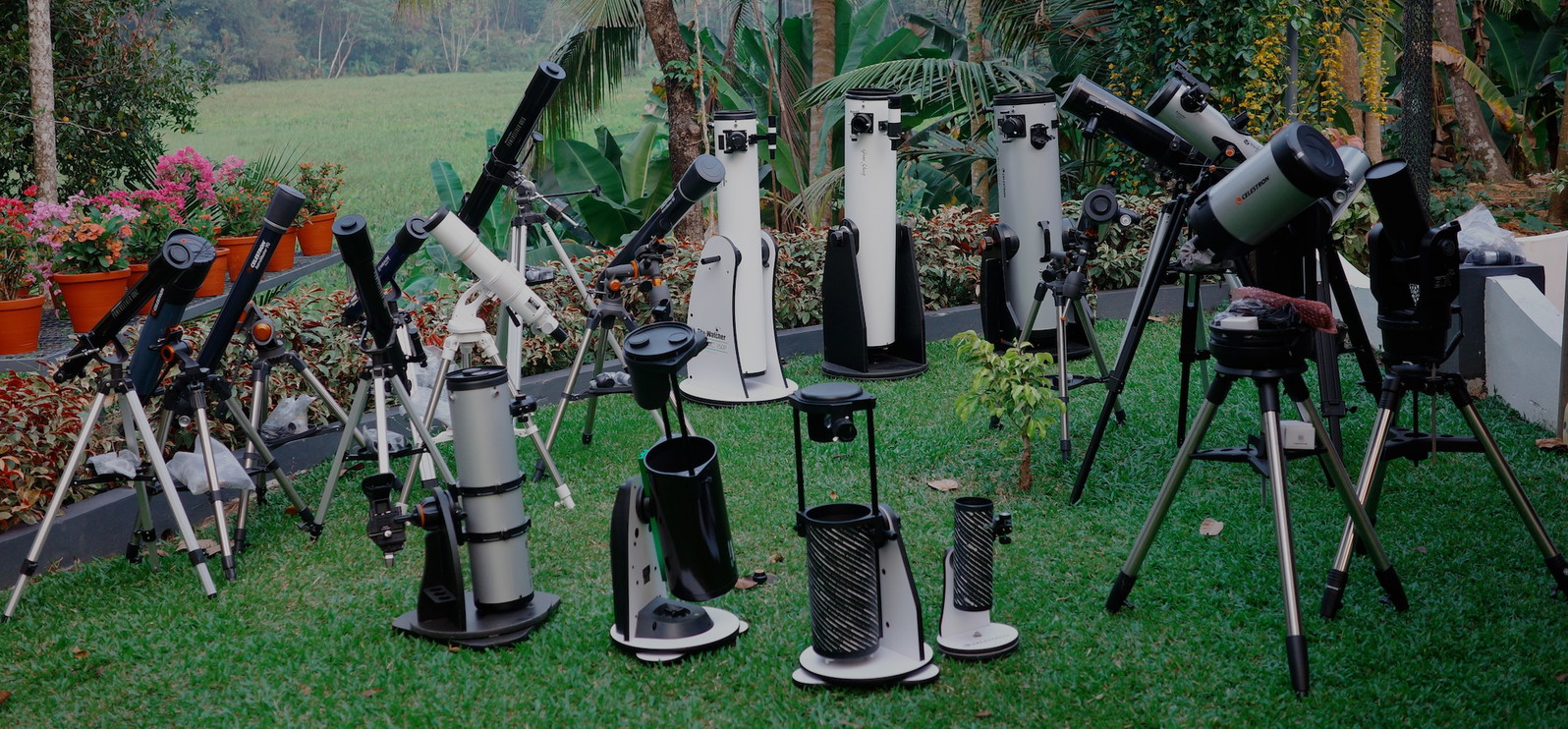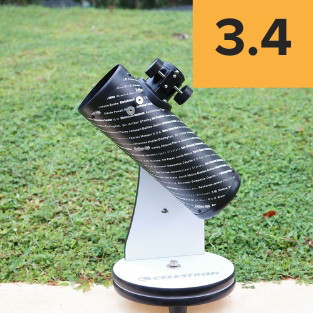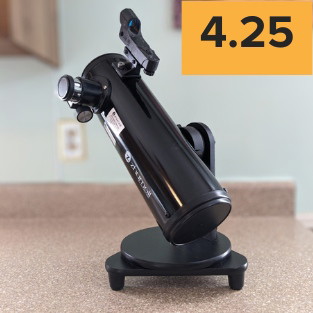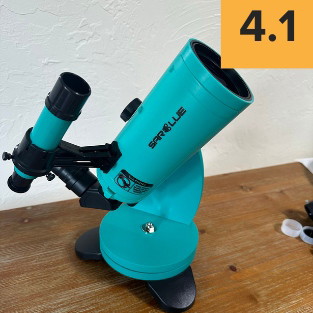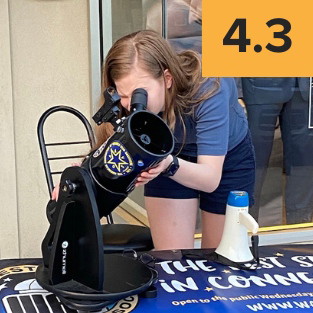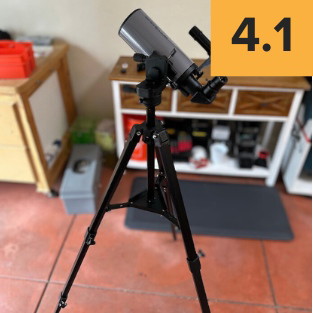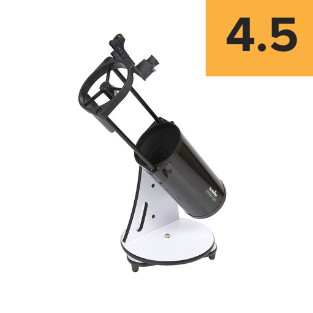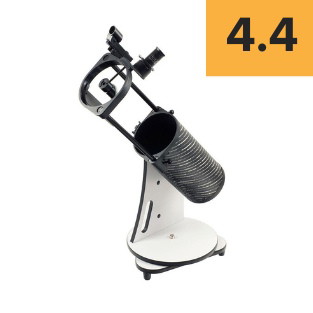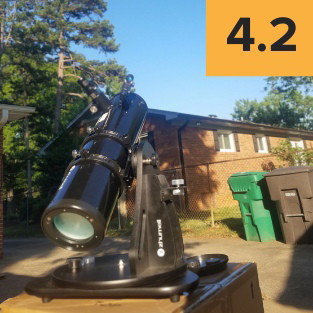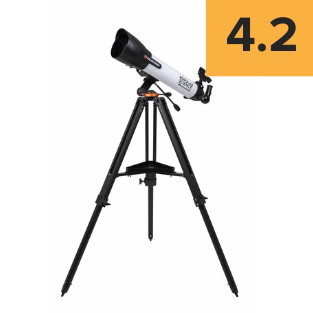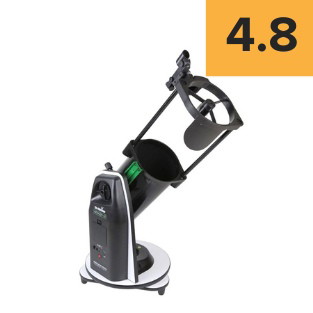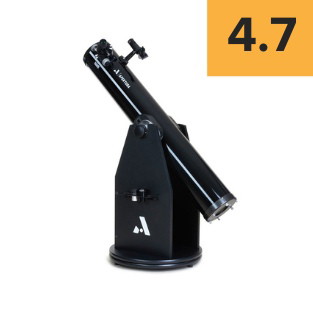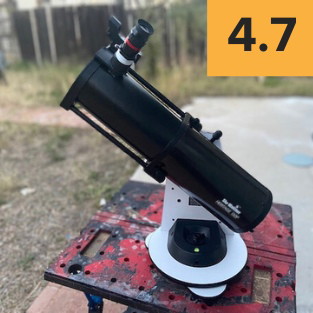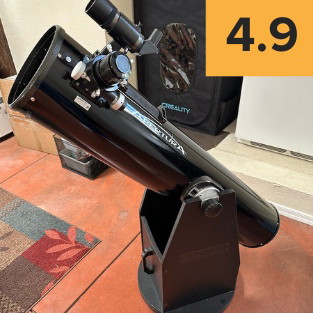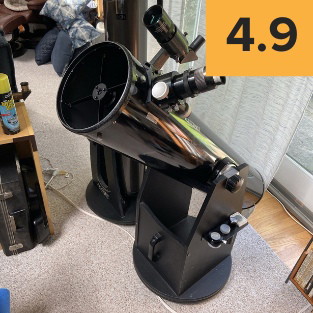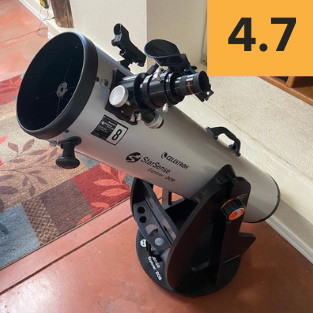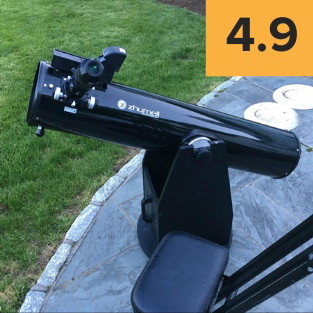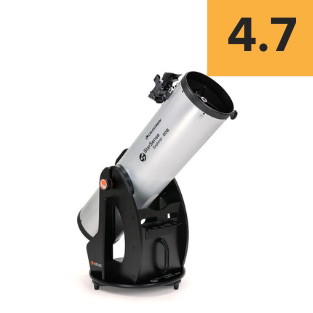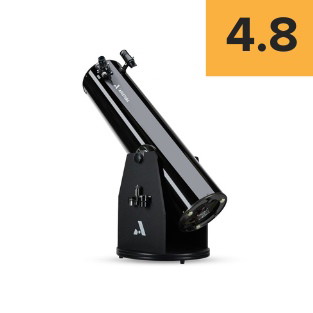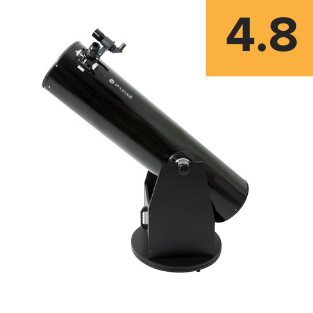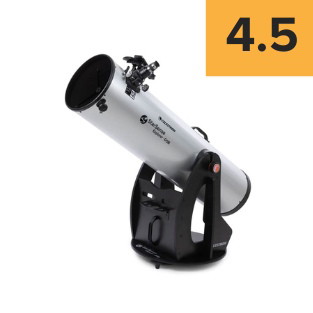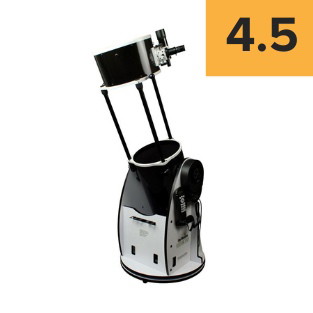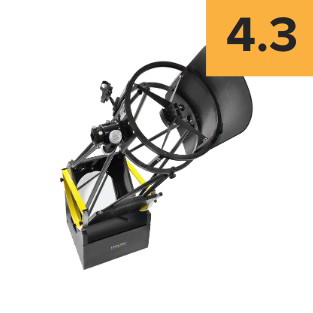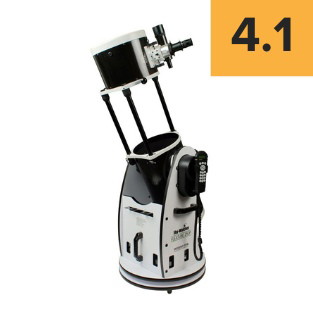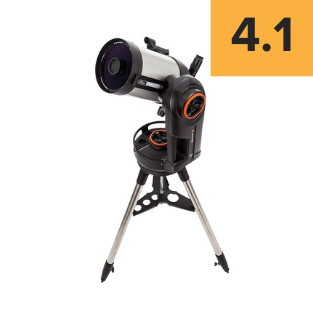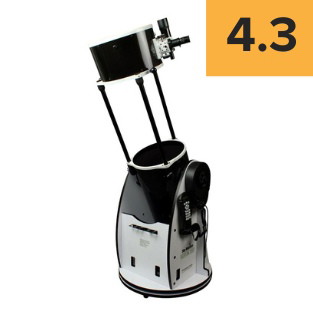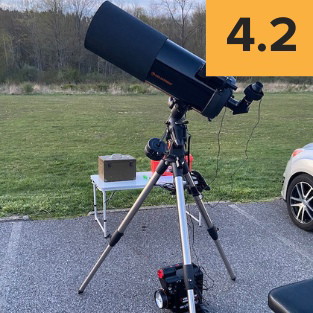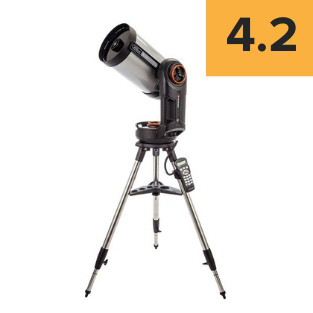Rank Category: Telescopes in the ~$3000-$6000 range
In addition to the unfathomable number of possible optical tube and mount combinations available for astrophotography, or if you just like refractors a lot, a budget of $3000 or more allows you to enter a world of premium-tier and custom scopes, ranging from 14”, 16″, and even 18” Dobsonians to ultra-premium smaller Dobs, beefy equatorial mounts, and giant catadioptrics.
Best Value
Explore Scientific 16″ Truss Tube Dobsonian
Rank 1
4.8/5
The Explore Scientific 16” Truss Tube Dobsonian offers a lot of performance and premium features at a remarkably low price for its size. You get huge altitude bearings with smooth glassboard-on-Teflon motions, built-in fans, front-adjusted collimation and of course high-quality 16” optics for mind-blowing views of deep-sky objects.
New Moon 12.5″ Hardwood Telescope
Rank 2
4.7/5
New Moon’s premium custom telescopes are expensive but offer exceptional views thanks to their handmade optics and ultra-smooth motions, along with an excellently designed and durable mechanical structure handcrafted to order.
New Moon 10″ Hardwood Telescope
Rank 3
4.7/5
One of the highest-quality and most compact options for a 10” instrument available with the same attention to detail as all of New Moon’s models, if you are interested in the best possible observing experience but don’t want to deal with a monster scope the 10” model from New Moon might be for you.
Rank 4
4.7/5
The 14” Sky-Watcher FlexTube is solely available in a GoTo configuration, which makes it a little more bulky and expensive, though it features the ability to be aimed manually, too thanks to its FreedomFind encoders, while the GoTo system is easily operated via your smartphone/tablet. Even when collapsed, the 14” FlexTube is huge compared to a true truss tube scope of this size, but it’s easy to transport and store in most situations.
Best Astrophotography
Celestron 8″ CGX 800 RASA
Rank 5
4.7/5
The Celestron 8” RASA is a great astrophotography instrument, and the CGX mount is a rock-solid platform for imaging with it, enabling very long exposures with fewer limitations than a smaller and lower-quality mount option.
Celestron CGX 1100 RASA
Rank 6
4.7/5
The Celestron 11” RASA is pushing the CGX somewhat for the most demanding imaging applications and can be a little much to get used to for those coming from smaller imaging setups, but it’s a fabulous research-grade option for quality deep-sky images – though at only 560mm focal length, not all targets are going to be optimally framed.
Celestron CGX 925 EdgeHD
Rank 7
4.6/5
While perhaps a little overkill for visual use, the Celestron CGX makes for a rock-solid platform for imaging with the EdgeHD 9.25” optical tube and an f/7 reducer, while also being fairly good for visual observation without too much complexity or bulk and an easy user interface with its hand controller.
Rank 8
4.6/5
The Celestron CGX is more than adequate for astrophotography purposes with the EdgeHD 8” optical tube, and is usable for a variety of imaging and visual tasks at f/2, f/7, native f/10 or with a Barlow lens for a longer f/raito. However, the CGX is capable of supporting the larger C9.25 EdgeHD too.
Celestron CGX 1100 EdgeHD
Rank 9
4.5/5
The Celestron CGX mount is more than enough to hold the C11 or EdgeHD 11 optical tubes for visual observation and decent enough for long-exposure deep-sky astrophotography, though a beefier and probably permanent mount would be more ideal for the job. The views through this scope are a delight too.
Rank 10
4.4/5
The Celestron CGEM II makes for an ideal mount for the C11 XLT for visual astronomy and planetary imaging use, being much sturdier than the Advanced VX and more compact than the CPC or larger CGX mounts. Neither the scope nor CGEM II is ideal for deep-sky imaging, but the C11 XLT is a fabulous scope for the visual observer or planetary imager.
Rank 11
4.4/5
The Celestron CPC 1100 is the largest of the three CPC scopes and is the only alt-azimuth mounted configuration offered for the C11 XLT optical tube. However, it is rather bulky and heavy as the C11 is permanently attached to the heavy-duty fork mount, which can make storage and transport difficult.
Sky-Watcher 16″ Flextube SynScan GoTo Dobsonian
Rank 12
4.4/5
The Sky-Watcher 16” FlexTube Dobsonian is an enormous instrument; even when collapsed, the scope easily fills a typical car and is a far cry from the portable form factor of an actual truss Dobsonian design when dismantled. The GoTo base is also extremely heavy/bulky even when dismantled into its separate pieces. However, the views, as well as the functionality of the high-quality GoTo system and FreedomFind encoders, do not disappoint, and planetary imaging with this scope is also possible.
Best Performance
Hubble Optics 18″ Premium Ultra Light Dobsonian Telescope
Rank 13
4.4/5
While most of the Hubble Optics Dobsonians are essentially “kit” telescopes with mechanical issues out of the box, the UL18 delivers unmatched performance for the price, and a savvy user can get one working in relatively short order.
Hubble Optics 16″ Premium Ultra Light Dobsonian Telescope
Rank 14
4.4/5
The Hubble Optics UL16 is a fairly compact and portable example of a 16” Dobsonian; as with the other Hubble scopes it can need some tweaking (as well as additional accessories) to work at its best but is generally a fine scope.
Hubble Optics 14″ f/4.6 Premium Ultra Light Dobsonian Telescope
Rank 15
4.4/5
While delivering less aperture, the Hubble Optics UL14 is probably the most mechanically sound model of the Hubble Optics lineup and performs fairly well out of the box, with decent optics and a very compact form factor when dismantled.
Rank 16
4.3/5
The Celestron CGEM II mount isn’t much of an upgrade from the Advanced VX for imaging purposes, though it’s adequate and a little steadier with the 8” RASA. However, we would recommend springing for an EQ6Ri Pro or CGX mount instead if you can afford it.
Rank 17
4.3/5
The CPC 9.25 is bulkier and heavier than the NexStar Evolution 9.25” but is significantly more sturdy. The CPC fork mount is simpler to set up than an equatorially-mounted configuration of the C9.25 XLT optical tube, though it’s of course a lot heavier and less versatile. You should probably consider an equatorial mount for the C9.25 XLT regardless of what you plan to do with it, but of the alt-azimuth C9.25 and mount configurations the CPC is definitely the better choice.
Rank 18
4.2/5
The regular Celestron C9.25 is not ideal for deep-sky astrophotography compared to the EdgeHD version, and the CGX mount is overkill with this scope for visual use. As such, there’s not much of a point in purchasing though the CGX makes for a fine mount with plenty of capabilities.
Celestron CGX 800 SCT
Rank 19
4.2/5
The Celestron C8 XLT is extremely overmounted for visual use on the CGX while being sub-par for deep-sky astrophotography compared to the EdgeHD or RASA designs. As such, while there’s nothing inherently wrong with the scope, we do not recommend this combination as highly compared to those options.
Celestron CGEM II 800 EdgeHD
Rank 20
4.1/5
The Celestron CGEM II can technically carry the 8” EdgeHD optical tube for deep-sky imaging, but it’s subpar for the job compared to other mounts with stepper motors, and overkill for visual use compared to the Advanced VX (the EdgeHD optics are also unnecessary for the task).
Celestron CPC 1100 EdgeHD
Rank 21
4.1/5
The Celestron EdgeHD optical configuration offers few perceptible advantages over the regular C11 XLT for visual use or planetary imaging, but the CPC fork mount is not exactly the best for deep-sky astrophotography, even when paired with a wedge and autoguiding. It also possesses the same extremely bulky and heavy frame as the regular CPC 1100 model, which may be uncomfortable for many users to set up or transport.
Celestron CGEM II 925 SCT
Rank 22
4.1/5
The CGEM II is somewhat overkill for holding the C9.25 XLT for visual use while being completely insufficient for deep-sky astrophotography with such a big scope. However, it is a little steadier than the Advanced VX if you demand more rigorous requirements.
New Moon 8″ Hardwood Telescope
Rank 23
4/5
The 8” New Moon model uses much of the same hardware from their larger scopes which impairs a lot of its portability, and for such a small scope a collapsible or truss tube is not nearly as advantageous as the simplicity of a solid tube; the scope is also too stubby to stand on its own even at f/6 but a little big for a tabletop.
| Rank 24 | Celestron Advanced VX 11″ Schmidt-Cassegrain | 3.9 |
| Rank 25 | Hubble Optics 12” UltraPortable Dobsonian | 3.9 |
| Rank 26 | Vixen Optics SX2-A105MII Refractor Telescope | 3.9 |
| Rank 27 | Vixen Optics SD103S 103mm f/7.7 Apo Refractor Telescope with SX2 Mount | 3.9 |
| Rank 28 | Vixen Optics R200SS 200mm f/4 Reflector EQ Telescope with SX2 Mount and SB1 Controller | 3.9 |
| Rank 29 | Vixen Optics SD81S 81mm f/7.7 Apo Refractor Telescope with AP-SM Mount | 3.9 |
| Rank 30 | Vaonis Stellina | 3.8 |
| Rank 31 | Vixen Optics R200SS 200mm f/4 Reflector Telescope with SXD2-PFL Mount | 3.8 |
| Rank 32 | Questar 3.5” Standard | 3.8 |
| Rank 33 | Celestron CGX-L 9.25 SCT | 3.8 |
| Rank 34 | Celestron CGEM II 925 EdgeHD | 3.8 |
| Rank 35 | Celestron CGEM II 700 Mak | 3.8 |
| Rank 36 | Vixen Optics VC200L 8″ f/9 Cassegrain Telescope with SX2 Mount and SB1 Controller | 3.8 |
| Rank 37 | Vixen Optics VMC200L Telescope OTA with Sphinx SX2 Equatorial Mount and Star Book One | 3.7 |
| Rank 38 | Celestron CPC Deluxe 925 EdgeHD | 3.6 |
| Rank 39 | Celestron CPC Deluxe 800 EdgeHD | 3.6 |
| Rank 40 | Celestron Advanced VX 9.25″ EdgeHD | 3.5 |
| Rank 41 | Celestron CGX 700 Mak | 3.4 |
| Rank 42 | Vixen Optics A81M 81mm f/11.2 Refractor Telescope with SX2 Mount | 3.3 |
| Rank 43 | Unistellar eVscope 2 | 3 |

